3 and 4 Marks Question
- Draw a ray diagram of an image formed when an object is placed at a distance of 10 cm from a convex lens having a focal length of 20 cm. Write any two nature of the image. Calculate the power of the lens.
-
A ray diagram of an image formed when an object is placed at a distance of
10 cm from a convex lens having focal length 20 cm is shown below:
Nature of image is virtual, erect and magnified.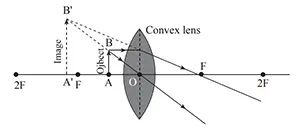
Here,
focal length (f) = 20 cm = 0.2 m
power (p) = ?
Now, we have,
p =
p =
∴ p = 5 D - Complete the ray diagram given alongside. Also mention any two natures of the image thus formed. If the power of the lens is +4D, what should be the distance between lens and magazine to read it properly?
-
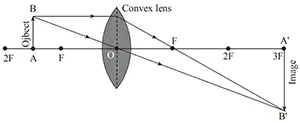
Its nature is real, inverted and magnified.
Here,
Power (p) = +4D
distance between lens and magazine = focal length (f) = ?
Now, we know,
f =
f =
∴ f = 0.25 m = 25 cm - Draw a ray diagram of an image formed when an object kept at a distance of 50 cm from a convex lens having focal length 20 cm. Write any two nature of image. Calculate the power of lens.
-
A ray diagram of an image formed when an object kept at a distance of 50 cm
from a convex lens having focal length 20 cm is shown below:
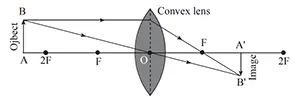
Nature of image formed is real, inverted and diminished.
Here,
focal length (f) = 20 cm = 0.2 m
power (p) = ?
Now, we have,
f =
p =
∴ p = 5D -
Study the given diagram and answer the following questions.
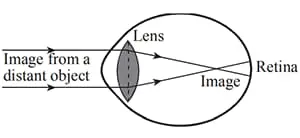
-
- What type of defect of vision is in the diagram of eye?
- The type of defect of vision is in the diagram of eye is short sightedness.
- What is the cause of this defect of vision?
-
The cause of this defect of vision is listed below:
- Due to the decrease in focal length of the eye lens.
- Due to the elongation of eye ball.
- What is to be done to remedy such defect?
- We can remedy such defect by wearing spectacles with concave lens of suitable power.
- Draw a diagram to show the remedy of this defect.
-
A diagram to show the remedy of this defect is shown below:
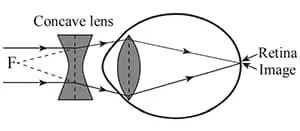
- Draw a ray diagram of an image formed when an object kept at a distance of 40 cm from a convex lens having focal length 20 cm. Write any two nature of image. Calculate the magnification of image.
-
A ray diagram of an image formed when an object kept at a distance of 40 cm
from a convex lens having focal length 20 cm is:
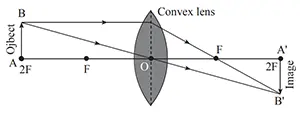
Nature of image formed is real, inverted and same size as that of the object.
Here,
As size of the object and image is same,
∴ Magnification == 1 =
- Draw a ray diagram of an image formed when an object is placed at a distance of 20 cm from a convex lens having focal length 20 cm. Write any two natures of image formed. Calculate the magnification of image.
-
A ray diagram of an image formed when an object is placed at a distance of
20 cm from a convex lens having focal length 20 cm is:
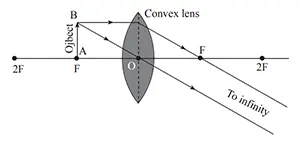
Nature of image formed is real, inverted and highly magnified.
Here,
height of object (O) = 20 cm
height of image (I) ∞
magnification (m) = ?
Now,
m =
∴ m = ∞ - Calculate the ray diagram of image formed by convex lens having focal length 2 cm, if lighting candle is placed 4 cm away from lens. Also calculate the magnification of lens.
-
The ray diagram of image formed by convex lens having focal length 2 cm, if
lighting candle is placed 4 cm away from lens is:

Here,
Image distance (v) = 4 cm
Object distance (u) = 4 cm
Magnification (m) = ?
Now, we have,
m =
=
= 1
∴ m = 1 -
Power of the given lens is +25D. Answer the following questions based on it.

-
- Find the distance FO.
-
Here,
Power (p) = +25 D
distance FO = focal length (f) = ?
We know,
f =
f =
∴ FO = f = 0.04 m = 4 cm - Draw a ray diagram of the image formed by this lens when an object is kept 7 cm away from the lens. Also write any three natures of the image so formed.
-
A ray diagram of the image formed by this lens when an object is kept 7
cm away from the lens is:
Nature of image formed is real, inverted and magnified.
-
Observe the defect of vision in the given diagram and answer the following
questions.

-
- What is the cause of this defect?
-
The cause of this defect (short sightedness) are listed below:
- Due to the decrease in focal length of the eye lens.
- Due to the elongation of eye ball.
- How can this defect be corrected? Illustrate with a ray diagram.
-
This defect can be corrected by wearing spectacles with concave lens of
suitable power.
